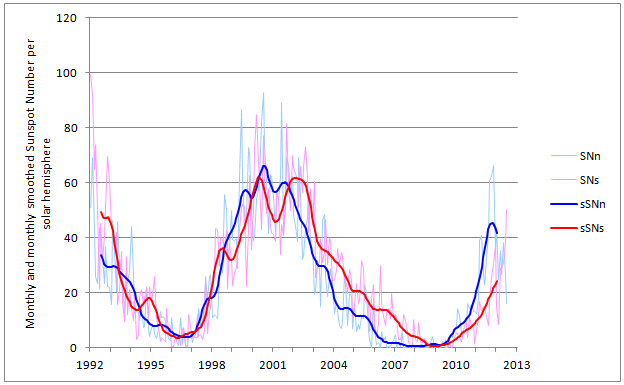Solar scientists are well aware that the solar activity can vary significantly on a month-to-month base during a solar cycle. That's why they take averages over longer period of times, to smooth out this jittery activity. Yet, despite this smoothing, the solar cycle often displays stand-stills during its rising or falling phase, or double or even triple maxima during the period of cycle maximum. This kind of behavior is even more pronounced when examining the activity per solar hemisphere. Graph underneath shows the evolution of the sunspot number per solar hemisphere, as determined by the Solar Influences Data analysis Centre (SIDC). The data in soft blue (north) and red (south) give the absolute monthly sunspot number, and the bright colored lines give the smoothed monthly sunspot number. It can readily be seen from the smoothed data that the hemispheric sunspot numbers are going up and down almost like a roller coaster. The graph also shows that the hemispheres do not mimick each other, peaking at different moments and at different levels.

The ongoing solar cycle 24 (SC24) seems not to be any different. Until early this year, the northern solar hemisphere has been dominating the solar activity. Most and biggest groups, highest sunspot numbers, highest numbers of solar flares, most energetic solar events: They were almost exclusively reserved for it. However, over the last few months, the southern hemisphere has been gearing up while northern activity decreased significantly. The images underneath were made by the Uccle Solar Equatorial Table (USET ) on 5 August 2010, 2 December 2011, and 30 July 2012. They provide typical views of the Sun during resp. the early phase of SC24, its subsequent rise dictated by northern activity, and the most recent take-over by the southern hemisphere.

Nobody knows for sure how high the peak of the southern sunspot number will be, how long the northern hemisphere will need to catch its breath, or how many peaks and valleys we may expect. But with the maximum solar activity of SC24 predicted for 2013, we may brace ourselves for the ride of the decade!
 |
 |





